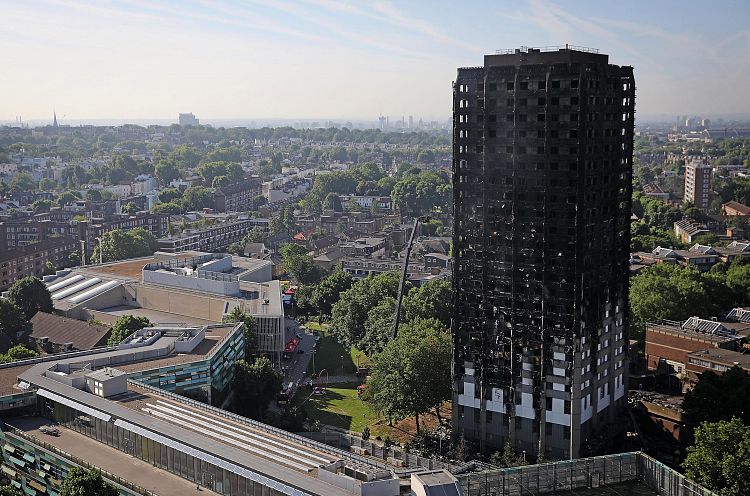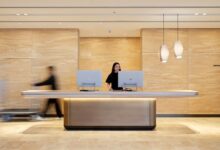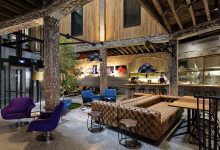
Time for serious action, not talk
The horror of the Grenfell Tower inferno in London on June 14 jarred the high-rise community in Australia, bringing back memories of the Lacrosse Building conflagration in Melbourne back in 2014.
Check out more articles like this in our monthly industry magazine, Resort News.
In both cases, exterior cladding on the exterior façade accelerated the spread of the fire vertically at an alarming rate and yet governments and councils in both cases were aware of the dangers posed by the cladding materials that are still being sold and installed on high-rise buildings.
The full extent of failings behind the Grenfell Tower inferno that killed 80+ people was exposed as police revealed that the fire started when a faulty fridge freezer on the fourth floor of the North Kensington block ignited cladding and insulation that failed all safety tests.
Scotland Yard issued a dramatic alert over materials used on the tower after samples caught alight easily during new independent tests. The tests on insulation samples taken from the tower were carried out by experts employed by Scotland Yard, which is carrying out a criminal investigation into how the fire started and why it took hold so easily.
Detective superintendent Fiona McCormack, who is overseeing the investigation, said early tests had been carried out on the cladding and insulation installed on the tower during a recent £8 million refit.
“What we are being told is that the cladding and that insulation failed all safety tests. The insulation was more flammable than the cladding.”
Celotex type RS5000 cladding was installed by Sussex company Harley Façades Ltd for £2.6 million as part of a £8.6 million renovation of the 24-storey residential complex just 12 months before the fire.
Celotex RS5000 was part of a cladding system that also consisted of exterior panels made from Reynolux-coated aluminium sheets over a Reynobond polyethylene core, according to a document in a 2014 planning application. Both have a fire rating of 0, the highest resistance to flames, but a firm involved in cutting the cladding tiles to shape said they should only be used on high-rise buildings with a non-flammable insulation.
A 50mm air cavity between the cladding with the flammable plastic core and the insulation layer compounded the problem as it fueled the blaze with oxygen.
Moreover, it has also emerged that the insulation used beneath the Celotex RS5000 cladding also came with fire safety warnings. The gas released if the temperature is high enough is hydrogen cyanide, which can be fatal if inhaled. Temperatures in the building reached an estimated 1000°C.
US firm Arconic Inc said it was stopping global sales of its Reynobond PE cladding for use in high-rise buildings after the fire.
The devastating inferno has raised concerns about the cladding used on the façades of buildings, mainly for insulation or to improve their appearance, prompting urgent safety tests to be carried out on similar tower blocks around the world.
“Right now, we are at a position where 95 buildings in 32 local authority areas have now failed the tests and that remains a 100 percent failure rate,” a UK government spokesman said in a media release.
On New Year’s Eve in 2016, flames engulfed the luxury 63-storey Address Hotel in Dubai, with its façade having been built with a material similar to the cladding on Grenfell and Lacrosse towers. After the hotel blaze, the third in Dubai in four years, Emirates rulers outlawed the use of aluminium composite panels in buildings.
In June 2015, Resort News analysed the aftereffects of the non-fatal inferno at the Pan Urban-developed Lacrosse Building in Melbourne’s Docklands district in November 2014.
The fire started by an unextinguished cigarette on an eighth floor balcony of the 23-storey tower and spread rapidly through the external cladding to the top level in just 11 minutes, resulting in the evacuation of 400 residents and a damage bill of more than $5 million.
The cladding was Chinese-made Alucobest and the Victorian Building Authority found that the cladding failed to comply with high-rise combustibility requirements as laid out in the Building Code of Australia. But, as Resort News pointed out at the time, the BCA stipulated that the external walls of apartment buildings do not need to be “fire proof” if they are non-load bearing and at least 3m away from the fire source, it nonetheless requires they at least be “non-combustible”.
Resort News quoted the chief executive of the Fire Protection Association of Australia Scott Williams as saying the cladding used at Lacrosse was widely used in the construction industry along with other materials that failed Australian design and safety standards.
Resort News and Strata Community Australia called on bodies corporate and owners corporations throughout Australia to immediately have building inspections to ensure their properties were compliant with all safety regulations.
Williams frighteningly surmised: “There are tens of thousands of non-compliant buildings with a range of non-compliant products.”
Despite concerns raised several times by the MFP, and an order from the City of Melbourne that the panels be removed, the cladding on the Lacrosse building remains in place and a battle over who has responsibility for paying the replacement costs is now before the Victorian Civil and Administrative Tribunal.
Alucobest and another Chinese sourced product, Haida, are among the most widely used cladding in Australia along with Vitracore offered by Fairview Architecture.
Cladding with a polyethylene core can be up to $35m² cheaper than products with fire-treated mineral or honeycomb aluminium cores.
Australian buildings are cloaked in “millions of square-metres” of flammable cladding, and authorities have been aware of the safety threat since at least 2010. The Australian Building Codes Board was told seven years ago that combustible cladding was widely installed across the nation.
But Victorian planning minister Richard Wynne has assured the public a fire of the magnitude of the Grenfell Tower blaze “would not be possible in Melbourne, or Australia, in fact. Because we have the strongest building codes of any first-world country.”
Not everyone is convinced. Metropolitan Fire Brigade commander Mark Carter said combustible cladding already identified in Melbourne was “outright dangerous and doesn’t lead to a good fire safety scenario”.
“The rate of fire spread is incredibly fast, an incredibly intense fire, you have lots of falling flammable particles raining down on fire fighters as they’re trying to enter and occupants as they’re trying to exit.”
Despite his confidence that a repeat of the Grenfell disaster could not be repeated here, Victorian planning minister Wynne has appointed former premier Ted Baillieu and former Labor deputy premier John Thwaites to lead an urgent taskforce probe into identifying dangerous buildings. It is understood the taskforce could investigate thousands of properties built over the past 12 years, with a focus on high-rise apartments.
Baillieu, himself an architect, said the cladding threat was a community safety matter that authorities needed to get a handle on as quickly as possible.
In addition to identifying dangerous cladding, the taskforce will oversee any rectification work and make recommendations about how to improve industry compliance with building standards.
Former planning minister John Thwaites, now chairman of the Australian Building Codes Board, said the taskforce would urgently consider if it could speed up cladding identification and testing in Victoria.
Independent federal senator Nick Xenophon has called for a national audit of all high-rise buildings for flammable cladding.
Fire safety expert Tony Enright said if cladding warnings had been sent out earlier “many buildings out there now with the 100 percent polyethylene core probably would not have received a building permit”.
The president of the Builders’ Collective of Australia, Phil Dwyer, said Xenophon’s audit does not go far enough. He said buildings with non-compliant cladding need to be urgently retro-fitted.
“It’s all very well for a senator to say, ‘let’s have an audit, let’s do something about it’, but if there is a risk of loss of life we need to be proactive not reactive.”
A senate inquiry into nonconforming building products was launched in June 2015 and, after several extensions, its final report is due at the end of October.
There is also concern among fire-fighting authorities about 800 buildings with suspect cladding that are not required to have sprinklers as they are less than 25m in height.
The absence of sprinklers in the London tower has been partly blamed for the ferocity of the fire.
The NSW Fire Brigade does not have the power to inspect buildings for the rate at which a fire may spread through external cladding even though the issue was made clear during a 2007 blaze where polyethylene composite panels helped destroy a Sydney factory.
The service still does not have jurisdiction under the state’s ¬Environmental Planning and -Assessment Act for such inspections despite the 2014 Melbourne apartment conflagration. The fire service can inspect building fire systems, such as sprinklers, exits and water pressure, but the laws do not extend to what role the entire outside of a building might play in a fire.
NSW fair trading minister Matt Kean has vowed to do whatever it takes to protect residents. The New South Wales government is expected to announce tough new measures to fire-proof high-rise buildings in the wake of London’s deadly Grenfell Tower inferno.
Other measures being floated by the government include lobbying its federal counterpart to put an import ban on the kind of cladding used on the Grenfell Tower and ensuring annual fire statements inform of a building’s cladding.
Thousands of commercial buildings, shopping centres, car dealerships and residential high-rise buildings on the Gold Coast feature external aluminium cladding — but builders say without lab testing it is virtually impossible to tell whether it has a flammable polyethylene core.
Gold Coast housing minister Mick de Brenni has tabled new laws that would spread responsibility for non-compliant products along the supply chain and create a $120,000 penalty for use of unsuitable materials. Currently there is no fine and legal responsibility rests solely with the installing contractors.
As it stands, the onus is currently on builders to ensure the product they choose meets the Australian Standard and is “fit-for-purpose” under the National Construction Code.
Cheap imported materials being used in high-rise construction is nothing new. In the past few months, a frightening series of ‘spontaneous’ glass balcony explosions in Melbourne apartment buildings has highlighted the dangers of cheap and faulty construction products flooding into Australia. The failures are suspected to be cases of exploding glass caused by poor manufacturing. It is thought the balcony balustrades contain nickel sulphide, which can cause glass to fail when exposed to extreme temperature change, wind or other stresses.
The exploding glass problem is not only confined to exterior use with increased number of cases where shower screens and sliding doors have spontaneously smashed, many causing injury.
Other products, including materials laced with asbestos, are arriving with fraudulent compliance certificates.
Consumer Affairs Victoria received 771 complaints and enquiries about “major failures” of defects in building goods in the last six months of 2016.
The Housing Industry Association said fraudulent certification had been discovered with plumbing, electrical fittings, window glass, engineered wood and steel products. But building products were rarely tested by customs when entering the country, the association said.
The Department of Immigration and Border Protection said it did not have “a legislated role” to check imported building products conform to standards.
The continued rise in imported building products has seen growing calls for a mandatory certification scheme, where building products are tested before being declared safe for use in Australian buildings for certain uses.
ARAMA CEO Trevor Rawnsley stresses: “Managers need to ensure that all fire safety processes are in order, that sprinklers are working, modern smoke alarms, fire doors and firefighting equipment are installed and adequate and unobstructed exit routes and access for emergency vehicles are in place.” Moreover, “Australian resident managers must be proactive to ensure that a tragedy like London does not happen to their buildings.
“ARAMA is also calling for all bodies corporate/owners corporations to review the maintenance plans and safety audits and ensure that sufficient funding is in place to undertake urgent fire safety remedial action work if necessary.”
Strata communities and resident managers also need to realise the insurance implications of unsafe building materials.
“Construction materials of the building play a big part in determining what you will or won’t pay for insurance and also if you will be covered or not in the event of a claim. Not accurately disclosing the true construction materials could result in a breach of the duty of disclosure resulting in no cover being in place should something devastating occur like what happened in London.”
Years overdue perhaps for legislative action banning the importing and use of unsafe building materials, but Australia has been extremely lucky not to have had a fatal high-rise fire and, it seems, the powers-that-be may need a tragedy to spur the urgent action that is needed to protect high-rise residents.
Along with ARAMA, Resort News urges bodies corporate, owner’s corporates, building managers and owners to have compliance inspections carried out before it is too late.

AccomNews is not affiliated with any government agency, body or political party. We are an independently owned, family-operated magazine.








Informative article Graham.
As manufacturers of Vitracore G2, we feel it useful to clarify that it’s popular because it’s NOT a PE (polyethylene) product.
It’s non-combustible core is constructed from a 100% aluminium structure – making it one of the most resilient nonflammable cladding solutions available. Vitracore G2 is a leading, non-combustible, Deemed-to-Satisfy composite panel, tested to AS1530.1.
Regards,
Ashley How
FAIRVIEW